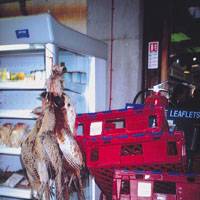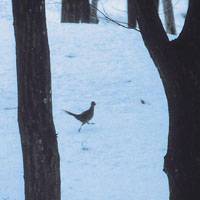The Green or Common pheasant was adopted as the national bird of Japan in 1947, and a pair of these kiji used to decorate the 10,000 yen note. Recently however, the noble pheasant, symbol of masculine might and courage -- and, through its sudden agitated flying and crying, supposedly a prophet of earthquakes -- has been replaced on that big bill by a strange creature that looks like a goosed rooster.
Pheasants often come to our garden here in the foothills of the Nagano Prefecture highlands, and during the hunting season we usually have a few to grace our table too. They breed around here as soon as the winter's snow has gone -- which will be in the next few weeks -- nesting on the ground in dense brush or grass, making simple hollow nests in which the hen lays a clutch of six to 12 pale-brown eggs. The hens are well camouflaged, with their mottled yellow-brown plumage and short tails. The males are rather gaudy fellows, with long tails that are dark green with black bars, bright-red wattles around the eyes, bluish-black heads and necks, their backs a mottled, glossy chestnut and their rumps and wing coverts a lovely yellow, grayish-green.
According to JT Nature page columnist Mark Brazil's epic work, "The Birds of Japan," the annual harvest of pheasants amounts to 500,000, with 100,000 of those having been bred and released to be shot.
Hateful damned nuisances
Ours, however, are all totally wild, and very nervous, for they have many enemies besides man -- including an increasing number of feral cats, hateful damned nuisances that should all be sent to samisen factories as far as I'm concerned.
A far rarer bird here is the Copper pheasant. The males are glorious, having copper-brown plumage with white spots, and darker underparts peppered with black spots. Their tails are very long, with broad bands of chestnut, black and white. They have small white patches under their eyes, which are otherwise ringed with red wattle. The females are very attractive too, but with plumage more suited to camouflage.
Yamadori, as they are called in Japanese, tend to keep to mountain forests, and they are elusive, weaving through the trees in very fast and sudden bursts of flight. The females are supposedly strictly protected, but they have lots of predators, and in our woods both they and their young are often taken by goshawks.
At our house, we might be lucky enough for either our forester, Mr. Matsuki, or my friend and neighbor, Mr. Kazama, to bring us one Copper pheasant a year. I think they are easily the most delicious of all game birds -- which is probably the main reason for their comparative rarity.
Apparently, Copper pheasants were once very abundant, and Mark Brazil tells us that in times past nearly a million were shot every year. I had a hunting licence in Japan for a few years, and though I may have walked all day in the hills and seen just one or two copper pheasants, I never had the heart to shoot. The more common Green pheasants, though, I would take whenever the opportunity arose.
Chinese pheasants were introduced to Britain from Caucasia and China toward the end of the 18th century to decorate rich folks' gardens and as game birds. Those Chinese cocks -- with their distinctive white collars -- were also introduced rather later to Hokkaido and Tsushima Island, between Kyushu and the Korean Peninsula. The Caucasian version is like the native Japanese Green pheasant, but has no white collar. According to my sources, this bird might have been introduced to Britain during the 400 years of Roman occupation that ended in the second century A.D. It was certainly quite common by the 11th century, when pheasant was oft-recorded on the menus of banquets and monastic feasts.
When I became old enough to legally use a gun in Britain I shot plenty of rabbits, pigeons and crows, and a few hares when I got permission from the landowner, but I avoided shooting pheasants. In those days, the only folk eating pheasants were either the "nobs" or poachers, and most pheasants were reared by gamekeepers to be released during the shooting season. So, when pheasants were around in the fields, a gamekeeper with his dog and 12-bore were likely to be near.
Long-time foes
I the old days in Britain, a poacher would either be hung or have the first two fingers of his right hand chopped off, a charming custom that Britain's long-time foes the French also followed when they caught British archers. Although that penalty was no longer imposed when I was young, poaching was still a very serious offence. (It is said that the vulgar British custom of waving two fingers -- equivalent to a raised middle finger -- arises from these times, when it was an invitation for confrontation by a man who still had the requisite fingers for pulling a deadly bowstring. Then when Winston Churchill, who used to wave his cigars around gripped between those same two fingers, was accused of being rude, he swiveled his wrist around and called it the "Victory Sign." Only in Japan, as far as I know, has this vulgarity been misinterpreted as a "peace" gesture.)
Nowadays, eating pheasant is far more common, and I usually enjoy it when I visit Britain. You will see them, feathered or plucked, for sale at markets, and in some country butchers' shops. The last time I had a British pheasant was at a hotel in Gloucestershire, in the rural southwest of the country, and it was one of the best I've tested. The tendons in its legs had ossified, so I knew that it was an older bird that had done a lot of running in its life, but the meat was still as tender and tasty as a big chick's. It had been steamed in white wine, then quickly browned in an oven.
With the hunting season over in Japan, I often have the pleasure of seeing families of pheasants foraging in our back yard, and it won't be too long before the males start crying their challenges to other males. It's one of my little joys to be able to enjoy bird-watching while sipping my morning cup of hot tea and honey. Much better than watching the news on television!




















With your current subscription plan you can comment on stories. However, before writing your first comment, please create a display name in the Profile section of your subscriber account page.